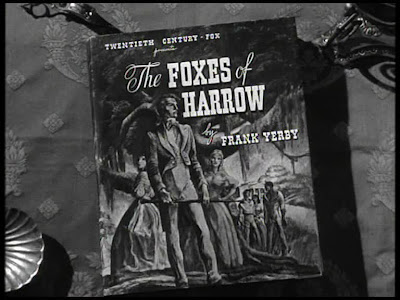The Foxes of Harrow
 Foxes of Harrow (2oth-Fox, John Stahl) is a historical drama set in antebellum New Orleans. At initial blush it seems to fit the genre formula: dynastic melodrama set on a Southern plantation; an Irish immigrant (Rex Harrison) who comes to America and moves from gambler to businessman in attempt to overcome his illegitimate status; his wife who is too guarded sexually to be able to deal with her husband; and tragic events that threaten to bring down the slave-owning patriarch.
Foxes of Harrow (2oth-Fox, John Stahl) is a historical drama set in antebellum New Orleans. At initial blush it seems to fit the genre formula: dynastic melodrama set on a Southern plantation; an Irish immigrant (Rex Harrison) who comes to America and moves from gambler to businessman in attempt to overcome his illegitimate status; his wife who is too guarded sexually to be able to deal with her husband; and tragic events that threaten to bring down the slave-owning patriarch. A couple of things are unusual about Foxes of Harrow, though. First, it lacks the visual style we associate with the antebellum or historical melodrama. The black-and-white cinematography looks downright low-key and realist in comparison.
 It's probably more accurate to call Joseph LaShelle's cinematography romantic minimalism than realist. Romantic, because its set ups provide washes of etherial light; minimalist because like Shamroy's work (also at Fox) it tends to be sparse with the number of lighting sources.
It's probably more accurate to call Joseph LaShelle's cinematography romantic minimalism than realist. Romantic, because its set ups provide washes of etherial light; minimalist because like Shamroy's work (also at Fox) it tends to be sparse with the number of lighting sources.

 Fitting with the Fox style, the result exploits a deeper and darker spectrum of grayscale than other studios' cinematography.
Fitting with the Fox style, the result exploits a deeper and darker spectrum of grayscale than other studios' cinematography.
 It's probably more accurate to call Joseph LaShelle's cinematography romantic minimalism than realist. Romantic, because its set ups provide washes of etherial light; minimalist because like Shamroy's work (also at Fox) it tends to be sparse with the number of lighting sources.
It's probably more accurate to call Joseph LaShelle's cinematography romantic minimalism than realist. Romantic, because its set ups provide washes of etherial light; minimalist because like Shamroy's work (also at Fox) it tends to be sparse with the number of lighting sources.
 Fitting with the Fox style, the result exploits a deeper and darker spectrum of grayscale than other studios' cinematography.
Fitting with the Fox style, the result exploits a deeper and darker spectrum of grayscale than other studios' cinematography.The second unusual aspect of the film is that the novelist for the source book, Frank Yerby, was African-American. As a best-selling writer of popular romance-historical novels, his work does not fit comfortably in the canon of African-American writing. Foxes, after all, has slave-owning white characters as protagonists. In the film version, there is a depiction of the dark side of the slave trade, as in an auction early in the film, during which the wandering camera emphasizes both the inhumanity of the spectacle and the complicity of the spectator of Old South movies who does not watch the forced labor propping up the lifestyle of the slaveowners.


Comments